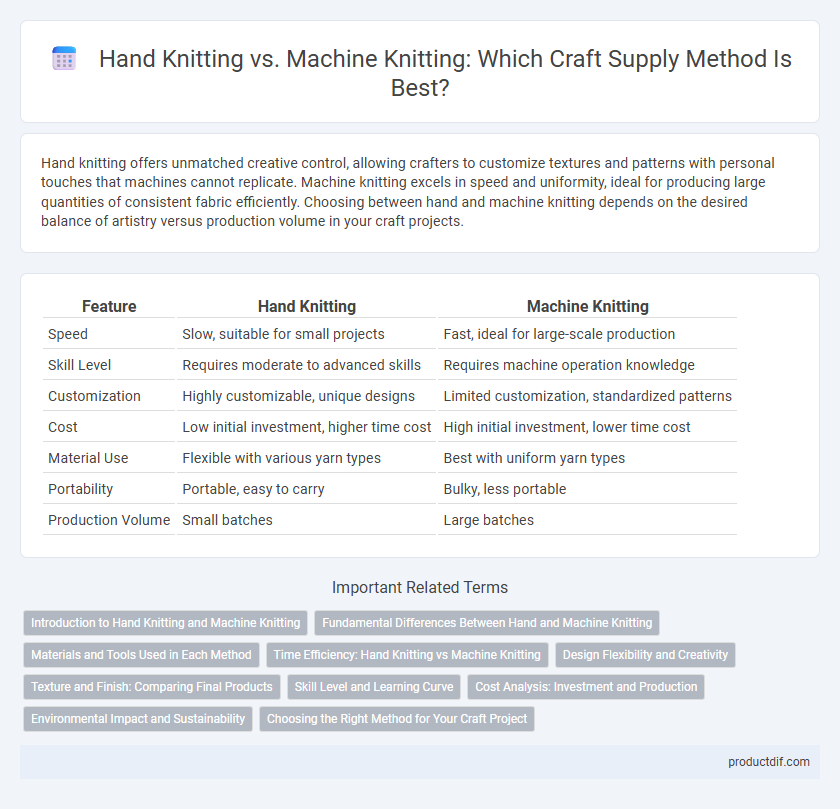Hand knitting offers unmatched creative control, allowing crafters to customize textures and patterns with personal touches that machines cannot replicate. Machine knitting excels in speed and uniformity, ideal for producing large quantities of consistent fabric efficiently. Choosing between hand and machine knitting depends on the desired balance of artistry versus production volume in your craft projects.
Table of Comparison
| Feature | Hand Knitting | Machine Knitting |
|---|---|---|
| Speed | Slow, suitable for small projects | Fast, ideal for large-scale production |
| Skill Level | Requires moderate to advanced skills | Requires machine operation knowledge |
| Customization | Highly customizable, unique designs | Limited customization, standardized patterns |
| Cost | Low initial investment, higher time cost | High initial investment, lower time cost |
| Material Use | Flexible with various yarn types | Best with uniform yarn types |
| Portability | Portable, easy to carry | Bulky, less portable |
| Production Volume | Small batches | Large batches |
Introduction to Hand Knitting and Machine Knitting
Hand knitting involves creating fabric by manually looping yarn with knitting needles, offering unmatched control over stitch patterns and texture, ideal for personalized and intricate designs. Machine knitting utilizes powered equipment to produce fabric quickly, suitable for large-scale production and consistent stitch quality, enabling efficient creation of garments and accessories. Both methods play essential roles in craft supply, catering to different skill levels and project scales.
Fundamental Differences Between Hand and Machine Knitting
Hand knitting involves manually creating fabric stitch by stitch using needles, allowing for intricate patterns and personalized designs. Machine knitting utilizes automated equipment to produce larger quantities of fabric quickly and uniformly, ideal for mass production. The fundamental difference lies in the level of control and customization, with hand knitting offering flexibility and uniqueness, while machine knitting emphasizes speed and consistency.
Materials and Tools Used in Each Method
Hand knitting primarily uses natural fibers like wool, cotton, and alpaca, with tools including knitting needles in various sizes and materials such as bamboo, metal, and plastic. Machine knitting employs synthetic or blended yarns optimized for speed and consistency, utilizing automated machines with multiple needles to produce uniform stitches quickly. Both methods require specific materials and tools tailored to their unique processes, influencing the texture and durability of the final fabric.
Time Efficiency: Hand Knitting vs Machine Knitting
Machine knitting significantly reduces production time, enabling crafters to complete complex patterns within hours that may take days by hand. Hand knitting, although slower, offers precise control and customization not easily replicated by machines. For large-scale projects or rapid output, machine knitting stands out as the most time-efficient method.
Design Flexibility and Creativity
Hand knitting offers unmatched design flexibility and creativity, allowing crafters to customize patterns, experiment with unique stitches, and incorporate intricate textures that machines often cannot replicate. Machine knitting excels at producing uniform, complex designs quickly but limits spontaneous modifications and personalized artistic expression. Artists seeking bespoke, one-of-a-kind creations prefer hand knitting to fully explore their creative potential and detailed craftsmanship.
Texture and Finish: Comparing Final Products
Hand knitting produces fabrics with unique textures characterized by slight variations in tension and stitch size, resulting in a more artisanal, textured finish. Machine knitting offers consistent stitch uniformity and a smoother, more polished appearance, ideal for mass-produced items. The final product's texture in hand knitting often feels warmer and more elastic, while machine knitting delivers durability and precision in pattern repetition.
Skill Level and Learning Curve
Hand knitting requires an intermediate skill level with a moderate learning curve due to the need for manual dexterity and pattern understanding. Machine knitting demands advanced technical skills and a steeper learning curve because operators must navigate complex machine settings and maintenance. Beginners often find hand knitting more accessible for developing foundational skills before progressing to machine techniques.
Cost Analysis: Investment and Production
Hand knitting demands a lower initial investment, requiring only basic tools such as needles and yarn, making it accessible for hobbyists and small-scale producers. Machine knitting involves a significant upfront cost for purchasing and maintaining knitting machines but enables higher production speed and volume, reducing the cost per unit in large-scale manufacturing. Evaluating cost efficiency depends on production scale, with hand knitting favoring custom, low-volume projects and machine knitting better suited for mass production with consistent quality.
Environmental Impact and Sustainability
Hand knitting significantly reduces carbon emissions compared to machine knitting by eliminating reliance on electricity and industrial machinery. The use of natural fibers and minimal waste in hand knitting supports sustainable crafting, whereas machine knitting often involves synthetic materials and higher resource consumption. Choosing hand knitting aligns with eco-friendly practices, promoting a circular economy within the textile craft community.
Choosing the Right Method for Your Craft Project
Hand knitting offers unparalleled control over stitch customization and texture, ideal for intricate patterns and personalized projects. Machine knitting speeds up production and ensures uniform stitches, suitable for large-scale or consistent fabric creation. Selecting the right method depends on project complexity, time constraints, and desired fabric characteristics.
Hand knitting vs Machine knitting Infographic

 productdif.com
productdif.com